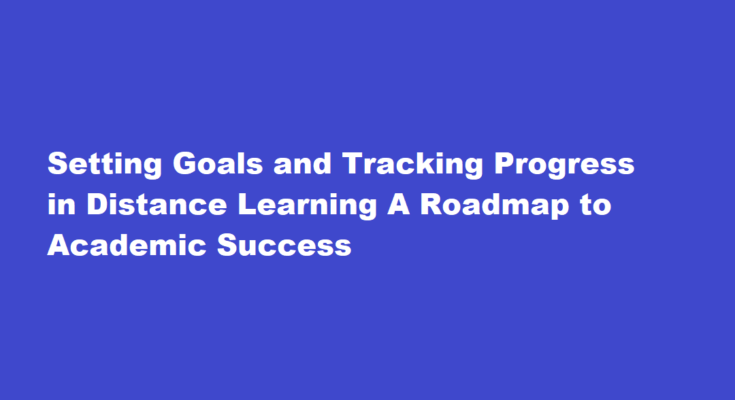Introduction
Setting goals and tracking progress are essential elements of achieving academic success in distance learning. As the virtual classroom continues to grow, learners must develop effective strategies to stay focused, motivated, and on track. In this article, we will explore practical approaches to set meaningful goals and implement tracking methods that empower you to excel in your distance learning journey.
Set SMART Goals
- When setting goals, ensure they are Specific, Measurable, Attainable, Relevant, and Time-bound (SMART). Define your objectives clearly, establish measurable criteria for success, and set realistic timelines. For example, instead of “improve grades,” set a SMART goal like “increase my grade by 10% in Math by the end of the semester.”
Break Goals into Milestones
- Breaking larger goals into smaller milestones makes them more manageable and allows you to track progress more effectively. Divide your goals into smaller tasks or checkpoints, and celebrate each milestone achieved. This approach not only provides a sense of accomplishment but also helps maintain motivation throughout your distance learning journey.
Utilize a Planner or Digital Calendar
- Maintain an organized schedule by utilizing a planner or digital calendar. Note important deadlines, assignments, exams, and study sessions. Plan your time accordingly to ensure that you dedicate sufficient effort to each task. Regularly review your schedule to stay on track and adjust as needed.
Create a Study Plan
- Developing a study plan is crucial in distance learning. Outline the topics, readings, and assignments you need to cover for each course. Allocate specific study times and create a routine that fits your learning style and preferences. Consistency and discipline in following your study plan will help you make steady progress.
Use Progress Tracking Tools
- Leverage technology to track your progress effectively. Many learning management systems offer progress tracking features that allow you to monitor completed assignments, grades, and overall course progress. Additionally, consider using productivity apps or online tools designed specifically for goal tracking and habit formation.
Reflect and Evaluate Regularly
- Take time to reflect on your progress and evaluate your performance regularly. Assess whether you are meeting your milestones and if your goals remain relevant. Identify areas of improvement and make adjustments as needed. Reflection and evaluation provide valuable insights for refining your approach and achieving better results.
Seek Accountability and Support
- Share your goals and progress with a trusted friend, family member, or mentor who can provide accountability and support. Regular check-ins with someone who understands your aspirations and challenges can keep you motivated and provide encouragement during challenging times.
Stay Motivated with Rewards
- Reward yourself when you achieve your milestones or reach significant goals. Treat yourself to something you enjoy, such as a favorite meal, a leisure activity, or some time for self-care. Rewards help reinforce positive behavior and provide a sense of gratification for your hard work.
Adapt and Readjust
- Recognize that goals and circumstances may change over time. Be flexible and willing to adapt your goals and study plan accordingly. Life events, unforeseen challenges, or changes in priorities may require you to readjust your approach. Embrace adaptability and be open to finding new ways to achieve your objectives.
Conclusion
Setting goals and tracking progress are fundamental to achieving academic success in distance learning. By setting SMART goals, breaking them into milestones, utilizing tracking tools, and seeking support, you can stay focused, motivated, and on track. Regular reflection, evaluation, and adjustments will ensure that your goals remain relevant and help you adapt to any challenges along the way. With a clear roadmap and effective progress tracking, you are well-equipped to excel in your distance learning journey.
Frequently Asked Questions
How can I ensure that my goals are realistic and attainable in distance learning?
Set goals that are specific, measurable, and realistic. Consider your current commitments, available resources, and time constraints. Be honest with yourself about what you can realistically achieve and ensure that your goals align with your capabilities.
Is it necessary to track progress for every task or assignment in distance learning?
While tracking progress for every task is not necessary, it is beneficial to track milestones and key assignments to ensure you are making progress toward your overall goals. Focus on tracking the tasks that have significant impact on your academic performance or are essential for achieving your objectives.
How often should I review and evaluate my progress in distance learning?
Regular review and evaluation of your progress are crucial for staying on track. Aim to review your progress weekly or bi-weekly, depending on the length and complexity of your goals. This frequency allows you to make timely adjustments and ensure that you are making steady progress.
How can I stay motivated and avoid procrastination while working towards my goals in distance learning?
Break your goals into smaller, manageable tasks to avoid feeling overwhelmed. Set realistic deadlines and establish a reward system to keep yourself motivated. Create a study routine that incorporates regular breaks and self-care activities to prevent burnout and maintain focus.
Can I revise my goals during my distance learning journey?
Absolutely. Your goals may need to be revised based on changing circumstances, new opportunities, or shifts in your priorities. Be open to adapting your goals and study plan as needed. Regular reflection and evaluation will help you determine when adjustments are necessary for continued growth and success.
Read Also : Effective Communication in Distance Learning Building Connections for Academic Success



